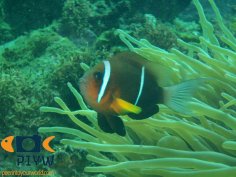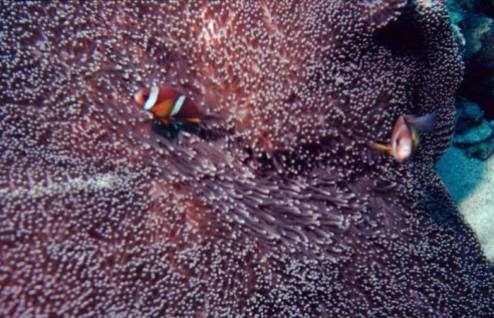Common Name: Oman Anemonefish
Scientific Name: Amphiprion omanensis Allen & Mee 1991
Distribution: Southern Oman, Socotra, and possibly Bir Ali, Yemen
Type Locality: Ras Kanasa, Barr Al Hikman, Oman
Identification: Two thin stripes; the anterior stripe often broken dorsally. Body color usually a dull, dark brown, though some specimens are closer to orange. Ventral fins dark in large specimens. Pectoral fins yellow; dorsal fin brown. Caudal fin white and strongly lunate.
Similar: Perhaps most similar to Amphiprion akindynos, which is similar in its color and pattern but lacks the orange pectoral fins of A. omanensis and has the caudal fin mostly rounded. The dark morph of Amphiprion cf chrysopterus “New Guinea” is an even closer match, having the same dark ventral fins and lunate, white caudal fin. Again, the dark pectoral fins are the best trait to separate these two.
Notes: This distinctive species is known from only a handful of locations, with the main population centered on the scattered reefs along Oman’s southern coastline. To the east, in Oman’s eastern reefs, it is replaced by Amphiprion cf clarkii “Arabia”. While the two have never been observed together, the broken anterior stripe usually seen in this population of the clarkii group hints at the possibility that these two have hybridized to some extent.
Amphiprion omanensis is known to hybridize with its closest relative, the Red Sea Anemonefish Amphiprion bicinctus, at Socotra. These hybrids possess thicker stripes and a re often lighter in color. Another possible hybrid has been observed at the isolated reefs of Bir Ali, Yemen, illustrated in a photograph seen below. More study is needed to determine the full extent of this species’ distribution in the Gulf of Aden.
The unique skunk anemonefishes of the Central Indian Ocean, A. nigripes and A. chagosensis, are unusual in possessing dark ventral fins, vertical stripes and in lacking the dorsal stripe common to every other member of its species group. While the overall morphology and ecology of these species clearly place them in the perideraion group, their phenotypic affinities with A. omanensis calls into question whether these disparate lineages have hybridized. Interestingly, the genetic phylogeny of Litsios & Salamin 2014 identifies these two skunk anemonefishes as the sister group to the bicinctus group, far removed from the rest of the perideraion clade. Hmm…
This species has likely never been exported for the aquarium trade. Captive specimens identified as A. omanensis are likely to be misidentified examples of the dark morph of A. cf chrysopterus “New Guinea”.




















